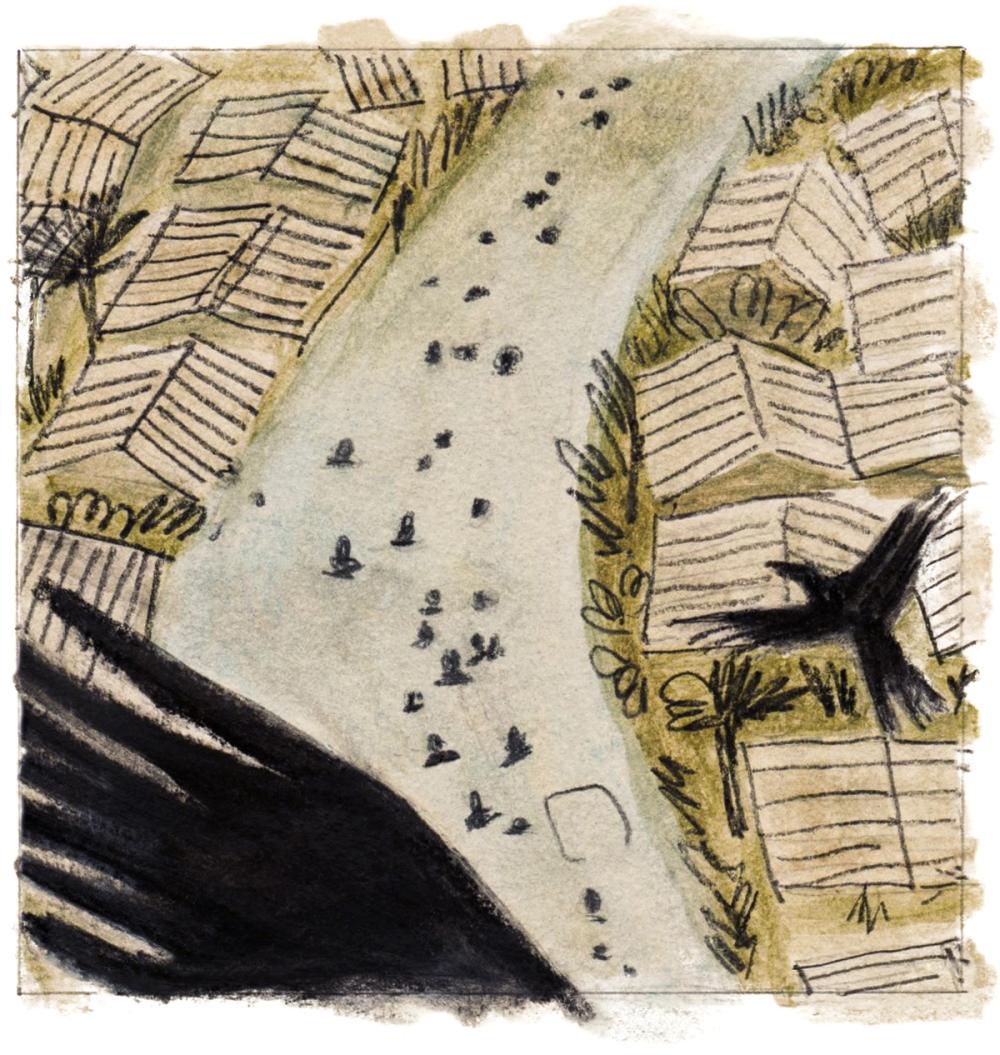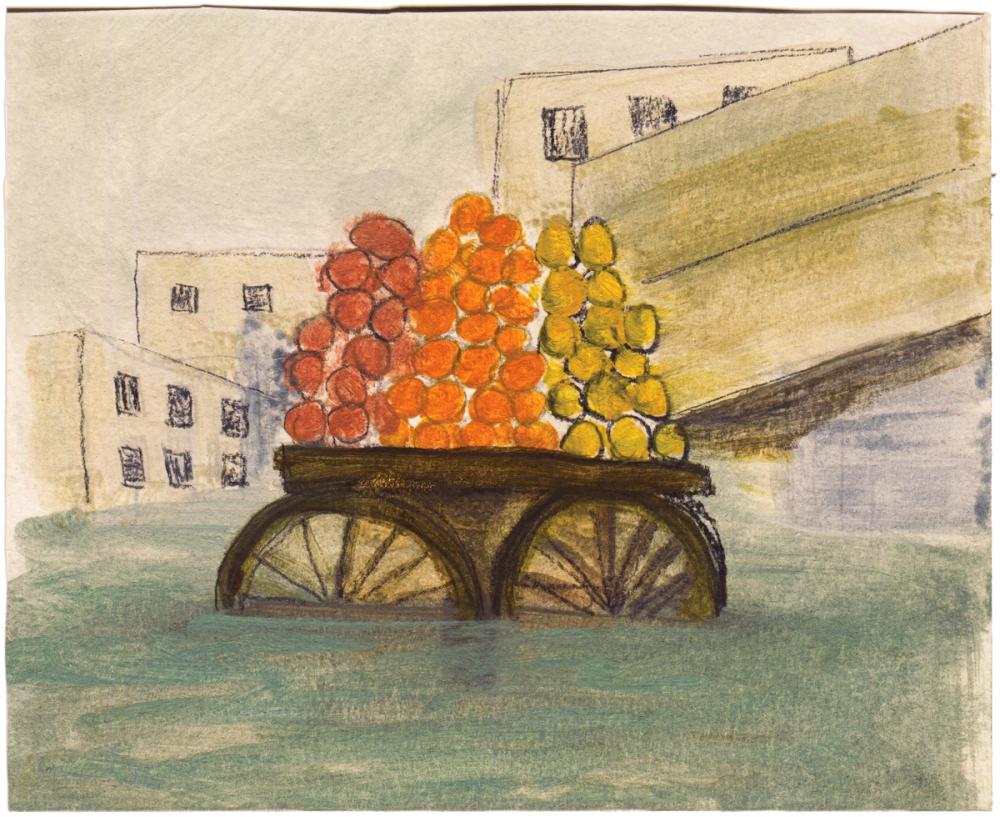Climate justice demands that people should be able to safely and easily cross borders if they are displaced by the climate emergency – especially as those forced to migrate are more likely to come from countries that pollute least.
The biggest global polluters are also those wealthier countries whose infrastructure and institutions are better able to withstand climate change. In the Global South, those with resource-dependent livelihoods who have contributed so little to the climate crisis are already the worst affected. And climate change will only intensify, magnifying existing inequalities. A 2019 UN report estimates that developing countries, having contributed 10% of global carbon dioxide emissions, will bear 75% of the financial costs, and warns of ‘climate apartheid’ – where the wealthy escape the worst effects, while the marginalised and dispossessed are left to suffer.

Climate change is already pushing people to move – Bangladesh, the Maldives, Central America and Sub-Saharan Africa being prime examples. As demonstrated in Kiera Dignan’s moving interviews with climate migrants in IFLA! Issue 4, it is now widely accepted, including by US military experts, that climate change played a causal role in the Syrian Civil War. From 2006-11, a succession of droughts caused 1.5 million people to move to the country’s cities, only to then have difficulty accessing food, water and employment. The war forced 6.6 million people to flee the country and a further 6.2 million to internally relocate.
States have a moral duty to co-operate to ensure that people forced to migrate can do so with dignity and rebuild their lives elsewhere, not least because the climate crisis and racist border systems have common cause – Western colonial projects that enslaved people of colour and extracted raw materials for profit. As Minnie Rahman explains, enslavement of Indigenous Peoples was ‘the only way that resource extraction could continue at the same pace so that colonial nations could thrive.’ Nadine El-Enany (Bordering Britain) illustrates how after subjugating races that they categorised as inferior, imperial powers like the UK turned to immigration law to insulate themselves from non-white immigration and protect the spoils of empire.
States have a moral duty to co-operate to ensure that people forced to migrate can do so with dignity and rebuild their lives elsewhere, not least because the climate crisis and racist border systems have common cause
As a result, people who are forced to migrate (including those displaced by the climate crisis) cannot safely cross borders or access the bare necessities upon arrival. External borders between countries are designed to prevent unauthorised movement and are increasingly policed, surveilled, and 'securitised' via state-of-the-art technology.
Internal borders in the UK and elsewhere permeate every area of life. The UK’s ‘hostile environment’ – a series of measures introduced under the 2014 and 2016 immigration acts – extended and strengthened internal borders. Access to housing, healthcare, education, employment, bank accounts, and driving licenses is contingent upon immigration status. Under this system, organisations and members of the public are forced to act as border guards and can be criminalised if they fail to properly enforce immigration laws. Irregularised migrants are often forced into destitution or exploitation and can be detained indefinitely.
How might people displaced by climate change navigate this system? One source of basic rights and entitlements is through the 1951 Refugee Convention, which defines a refugee as ‘someone who is unable or unwilling to return to their country of origin owing to a well-founded fear of being persecuted for reasons of race, religion, nationality, membership of a particular social group or political opinion’. It prohibits contracting states from forcibly returning refugees to situations where they face ‘torture, cruel, inhuman or degrading treatment or punishment and other irreparable harm’ – the principle of non-refoulment. The convention was born of the post-war era, where conflict and persecution may have been perceived by its architects as the main drivers of forced migration. There is little room in the definition for those forcibly displaced by climate change, who as a result, are not recognised under international law and are not entitled to any rights if they cross borders. Consequently, there is currently no such thing as a ‘climate refugee’.

A recent case concerning Ioane Teitiota, a man from Kiribati, sought to push the boundaries of this convention. He applied for protection in New Zealand in 2013, arguing his and his family’s lives were at risk. Rising sea levels had damaged fresh water supplies, caused environmental degradation, and reduced habitable lands on Kiribati’s islands – worsened by increasing storms. The UN Human Rights Committee refused the claim on the grounds that the situation could be rectified, but stated that it is unlawful for governments to return people to countries where their lives might be threatened by the climate crisis. Although the judgment is non-binding, it is hoped that it could set a helpful precedent and that the convention could be broadened to explicitly include climate refugees.
Expanding the definition of ‘refugee’, however, is no easy task. As Hodgkinson et al. argue, expanding the term to include those displaced by climate change might obscure important differences between various groups. Reasons for migration are complicated and often overlapping. As Dr Maya Goodfellow explains, ‘there’s a risk of becoming deterministic about it... when you look at the reasons why people move, climate can be a significant factor, increasingly so, but it’s also intersecting with existing problems that are produced by things like international development policy, international state policy.’ Other academics refer to climate factors as bringing people to a ‘tipping point’, pushing people to move. In the future, those cases where it is abundantly clear and demonstrable that climate change was the sole factor forcing an individual to migrate will be rare.
An institutional culture of disbelief pervades the UK’s asylum decision-making, with applicants asked to meet an extremely demanding burden of proof to demonstrate that they satisfy the definition of a refugee
It is difficult enough to conceive of an adequate definition of ‘climate refugee’, let alone one that states could agree on and put into practice. At what point does the decision to migrate move from ‘voluntary’ to ‘forced’, and how would a public authority such as the UK Home Office adjudicate such claims consistently? An institutional culture of disbelief pervades the UK’s asylum decision-making, with applicants asked to meet an extremely demanding burden of proof to demonstrate that they satisfy the definition of a refugee. Backlogs of those waiting in limbo for decisions have skyrocketed in recent years. These problems would likely only worsen if the Home Office were asked to adjudicate claims to satisfy the inevitably complex definition of a ‘climate refugee’.
There are other potential solutions. States could sign up to bilateral or multilateral agreements, outside of the Refugee Convention. There could be an increased focus on regional mobility agreements – the Intergovernmental Authority on Development (IGAD) in East Africa coordinates a free movement protocol that provides for people to move pre-emptively, or after a disaster. There are humanitarian visas or temporary protection status for those displaced by natural disasters, such as those offered by the US to Haitians after the 2010 earthquake. However, these ad hoc solutions could lead to inconsistency and would not fill all the gaps in coverage.
More ambitious and coordinated remedies – such as a global agreement akin to the refugee convention – face immense political obstacles. In the European context, protections built up under the Convention over the last seventy years are becoming increasingly unstable. The UK government is currently legislating to dismantle the existing asylum system and criminalise those who come to the UK to seek protection because it is considered politically expedient. This may well breach international law.

This issue is already being co-opted by those who seek to strengthen borders. Kate Aronoff has warned that ‘the racist right traffics in fear–and rising temperatures offer plenty to be afraid of.’ In this context the threat of ecofascism is pressing. As an ideology, ecofascism views increasingly securitised borders and harsher immigration policies as a necessary response to climate change. Leader of France’s Front National, Marine Le Pen, has called borders ‘the environment’s greatest ally’. Germany’s AfD and Italy’s populist five Star movement have also courted environmentalism in recent years.
Their views often dovetail with the Malthusian idea that population growth (particularly in the global south) will outstrip our ability to support people’s livelihoods. Once you believe that over-population in the Global South is part of the problem, it buttresses the idea that immigration controls are part of the solution, or at least are necessary to keep out the invading ‘masses’. In this view, climate migrants become another symptom of the climate crisis, rather than its victims.
Once you believe that over-population in the Global South is part of the problem, it buttresses the idea that immigration controls are part of the solution
In the run-up to the 2019 election, Danish Prime Minister Mette Frederiksen wrote that ‘climate change will force more people to relocate. And add to that the fact that the population of Africa is expected to double by about 2050,’ going on to argue for ‘reasonable limits’ on immigration. Despite preaching ‘reasonableness’, her government pursues a ruthlessly anti-immigrant agenda – the Danish ‘social democrats’ have repeated their campaign vision to have ‘zero asylum-seekers’ in Denmark; plan to ‘process’ asylum seekers in offshore camps in North African countries; introduced a ‘ghetto plan’ for asylum seekers, with limits on the proportion of ‘non-Western’ people living in a given area; and introduced mandatory ‘culture and values education’ for one-year-olds. Although the political projects of liberal politicians and the far-right are distinct in important ways, Dr Goodfellow is right to highlight a ‘shared discursive basis’ that frames movement as a threat, and presents ‘floods’ of migrants in highly racialised terms.
The politics that currently threatens all migration is obstructing new initiatives to protect climate migrants, and will continue to do so. At COP21, talks relating to proposals for a coordination facility for people displaced by climate change – including a plan which would have facilitated relocation for people displaced – were discontinued in part due to opposition from Australia, another country with a notorious immigration system.
We have little hope of securing justice for people displaced by the climate crisis if we do not challenge racism and xenophobia. To do so, we need broad movements rooted in a radical solidarity that address the multidimensional nature of the climate crisis. For too long the environmental, migrant rights, and other humanitarian movements have worked in siloes.
There is a sense that this may be improving. As Dr Kanta Kumari Ringaud told the BBC, ‘It’s taken us a while to lift climate out of this sort of remit of environmental ministries, to say that it’s a development issue that really cuts across the landscape, and migration suffers a little bit like that, it’s a cross-cut- ting issue.’ Jamie Peters, a campaigner with Friends of the Earth, echoed these sentiments, suggesting that the environmental movement has been adapting, citing their recent opposition to the Policing, Crime, Sentencing and Courts bill.
It is vital that the environmental movement takes a strong stand on punitive immigration controls. Changing attitudes to migration is one of the only ways to make meaningful political solutions viable, and that will require climate activists listening to those who have worked on these issues for decades.
It is vital that the environmental movement takes a strong stand on punitive immigration controls
As Dr Maya Goodfellow warns, those organisations must also take care to ‘really understand the terrain of the debate.’After all, it might seem tempting to refute ecofascist ideas in terms of the contribution that migrants could bring – that with plateauing population rates, ‘developed’ countries face a stark shortage of labour that migration may address; that migration is good for the economy, and that people forced to migrate due to climate issues have important knowledge and experience. These are undoubtedly true, and it is vital that we dispel the myths peddled to stoke up nationalism. However, arguing for basic rights and entitlements on the sole basis of contribution to the host nation contains an implicit racism that may play into ecofascist hands. We must argue for and create a world where people – particularly those who have done so little to contribute to the climate crisis – can migrate when the need arises.
We must also avoid sensationalist and dehumanising narratives of climate migration that fuel right-wing arguments for shoring up borders, and continue to challenge the ideas that migration is inherently problematic, or that borders make us safer. Immigration controls criminalise people, separate families, push people to make dangerous journeys, and force people into destitution, exploitation,and detention. None of this makes anybody safer.
The complexity of defining ‘climate refugee’ ought to make us think whether we should shoehorn the concept into the existing international border regime. Migration is inherently complicated and multi-causal in a way that present legal systems and border regimes are not sufficiently agile to absorb. By nature, providing evidence for forced migration is often difficult, and asylum processes are demeaning and retraumatising. Dispossessed and marginalised people should not be required to demonstrate that their migration was forced on account of specific reasons that map onto constructed legislative categories.
If climate justice means dismantling the power structures that produced the crisis in the first place, it also demands a clean break with the present system of immigration controls. It is not beyond us to imagine a world where people can migrate voluntarily – those with power and privilege generally can do so already. It is imperative that we articulate and fight for a world in which we all can.
See Sahar Shah’s discussion of open borders as a form of climate reparations on p.11 of this issue of It’s Freezing in LA!.
Philip Alston, Special Rapporteur on Extreme Poverty and Human Rights, 2019.
Australia promises that nobody coming to claim asylum by ‘irregular means’ would ever set foot on Australian soil, and has held people for years in offshore detention centres. Here in the UK, the Nationality and Borders Bill seeks to emulate much of this system, including offshore detention centres.
Nikesh Shukla, The Good Immigrant, 2016.
In the first six months of 2021, at least 1,146 people died trying to cross the Mediterranean.
More Reads
The matter that makes us will be here long after we are gone, but what kind of mark will we leave? In this IFLA! classic, from our Regeneration Issue, Phoebe Thomson explores deathscapes – 'landscapes of death' – and the legacies our bodies leave behind, from British cemeteries to Parsi Towers of Silence. She wonders whether a regenerative approach to handling death can breathe new life into old spaces. Illustrated by our very own Matthew Lewis.
Keep reading >
Landscapes
Death, Landscape, and the Environment
By Phoebe Thomson(Article)Landscapes
Death, Landscape, and the Environment
Keep readingThe matter that makes us will be here long after we are gone, but what kind of mark will we leave? In this IFLA! classic, from our Regeneration Issue, Phoebe Thomson explores deathscapes – 'landscapes of death' – and the legacies our bodies leave behind, from British cemeteries to Parsi Towers of Silence. She wonders whether a regenerative approach to handling death can breathe new life into old spaces. Illustrated by our very own Matthew Lewis.
By Phoebe ThomsonKeep readingArchitecture
A Call for Ancestral Futurism: decolonizing and decarbonizing architecture
Keep readingIn Jamaica, the ‘Isle of Wood and Water’, locals find themselves caught between traditional and modernist values, especially when it comes to building new homes. Teshome Douglas-Campbell explores this phenomenon through the lens of ‘Ancestral Futurism’, finding a new way forward that takes inspiration from architects and architecture from across the global South.
By Teshome Douglas-CampbellKeep readingPollution
Health on the Climate Frontline
Keep readingEven the briefest online search for ‘climate change impacts’ throws up a catalogue of harrowing events. Climate change is not something that ‘will happen’, it is well underway. It is already threatening human health, and health services, around the world. In this classic article from Issue 9, Pharmacist Jean Ong describes the changes she’s seen from Metro Manila in the Philippines. Illustrations by Inès Gradot for IFLA! Issue 9. Edited by Martha Dillon and Jackson Howarth.
By Jean OngKeep reading- Read more
